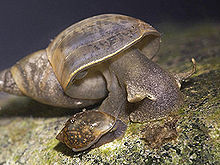Orthogastropoda was a major taxonomic grouping of snails and slugs, an extremely large subclass within the huge class Gastropoda according to the older taxonomy of the Gastropoda.
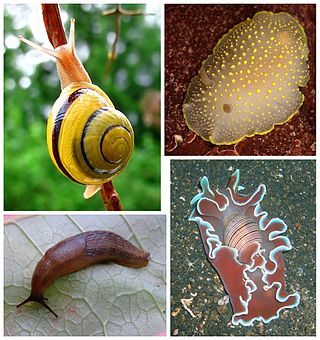
Heterobranchia, the heterobranchs, is a taxonomic clade of snails and slugs, which includes marine, aquatic and terrestrial gastropod mollusks.

Pulmonata or pulmonates, is an informal group of snails and slugs characterized by the ability to breathe air, by virtue of having a pallial lung instead of a gill, or gills. The group includes many land and freshwater families, and several marine families.

Littorinimorpha is a large order of snails, gastropods, consisting primarily of sea snails, but also including some freshwater snails and land snails.

Stylommatophora is an order of air-breathing land snails and slugs, terrestrial pulmonate gastropod molluscs. This taxon includes most land snails and slugs. Stylommatophorans lack an operculum, but some close their shell apertures with temporary "operculum" (epiphragm) made of calcified mucus. They have two pairs of rectractile tentacles, of which the upper pair bears eyes on the tentacle tips. All stylommatophorans are hermaphrodites.
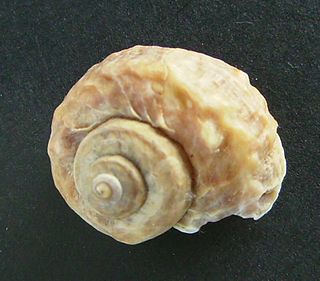
Amphibolidae is a family of air-breathing snails with opercula, terrestrial pulmonate gastropod molluscs.

Planorbidae, common name the ramshorn snails or ram's horn snails, is a family of air-breathing freshwater snails, aquatic pulmonate gastropod molluscs. Unlike most molluscs, the blood of ram's horn snails contains iron-based hemoglobin instead of copper-based hemocyanin. As a result, planorbids are able to breathe oxygen more efficiently than other molluscs. The presence of hemoglobin gives the body a reddish colour. This is especially apparent in albino animals.

The Systellommatophora is a clade of primitive, air-breathing slugs, according to the taxonomy of the Gastropoda.

Latia is a genus of very small, air-breathing freshwater snails or limpets, aquatic pulmonate gastropod molluscs in the superfamily Chilinoidea.

Ancylini is a tribe of small, freshwater, air-breathing limpets, aquatic pulmonate gastropod mollusks in the family Planorbidae, the ram's horn snails and their allies. This tribe used to be treated as a family; the current taxonomic placement within Planorbidae is according to the taxonomy of the Gastropoda.
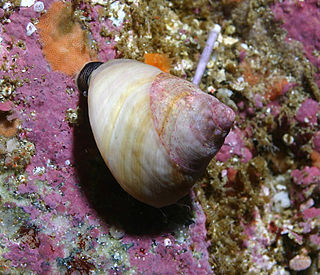
Trochoidea is a superfamily of small to very large vetigastropod sea snails with gills and an operculum. Species within this superfamily have nacre as the inner shell layer. The families within this superfamily include the Trochidae, the top snails. This superfamily is the largest vetigastropodan superfamily, containing more than 2,000 species.

Amphiboloidea is a taxonomic superfamily of air-breathing land snails.
The taxonomy of the Gastropoda, as revised by Winston Ponder and David R. Lindberg in 1997, is an older taxonomy of the class Gastropoda, the class of molluscs consisting of all snails and slugs. The full name of the work in which this taxonomy was published is Towards a phylogeny of gastropod molluscs: an analysis using morphological characters.

Apogastropoda was previously used as a major taxonomic grouping of sea snails, marine gastropod molluscs. This infraclass mostly consisted of marine limpets and operculate snails. At least 20,000 species were considered to exist within the two clades that were included, Heterobranchia and Caenogastropoda.

Turbinoidea was a superfamily of small to large sea snails, marine gastropod mollusks in the clade Vetigastropoda. But it has become an available name, because it is no longer used in the current taxonomy of gastropods sensu Williams et al. (2008).

Lottioidea is a superfamily of sea snails or limpets, marine gastropod mollusks in the clade Patellogastropoda, the true limpets.

Hygrophila is a taxonomic superorder of air-breathing freshwater snails, aquatic pulmonate gastropod mollusks within the clade Panpulmonata.

Freshwater snails are gastropod mollusks that live in fresh water. There are many different families. They are found throughout the world in various habitats, ranging from ephemeral pools to the largest lakes, and from small seeps and springs to major rivers. The great majority of freshwater gastropods have a shell, with very few exceptions. Some groups of snails that live in freshwater respire using gills, whereas other groups need to reach the surface to breathe air. In addition, some are amphibious and have both gills and a lung. Most feed on algae, but many are detritivores and some are filter feeders.
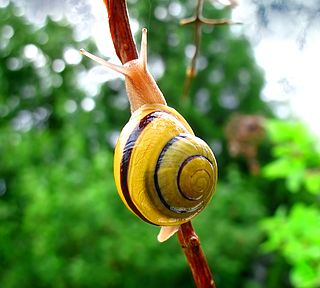
Panpulmonata is a taxonomic clade of snails and slugs in the clade Heterobranchia within the clade Euthyneura.

Lymnaeoidea, common name the pond snails, is a taxonomic superfamily of small to large air-breathing freshwater snails, aquatic pulmonate gastropod mollusks, that belong to the superorder Hygrophila.
